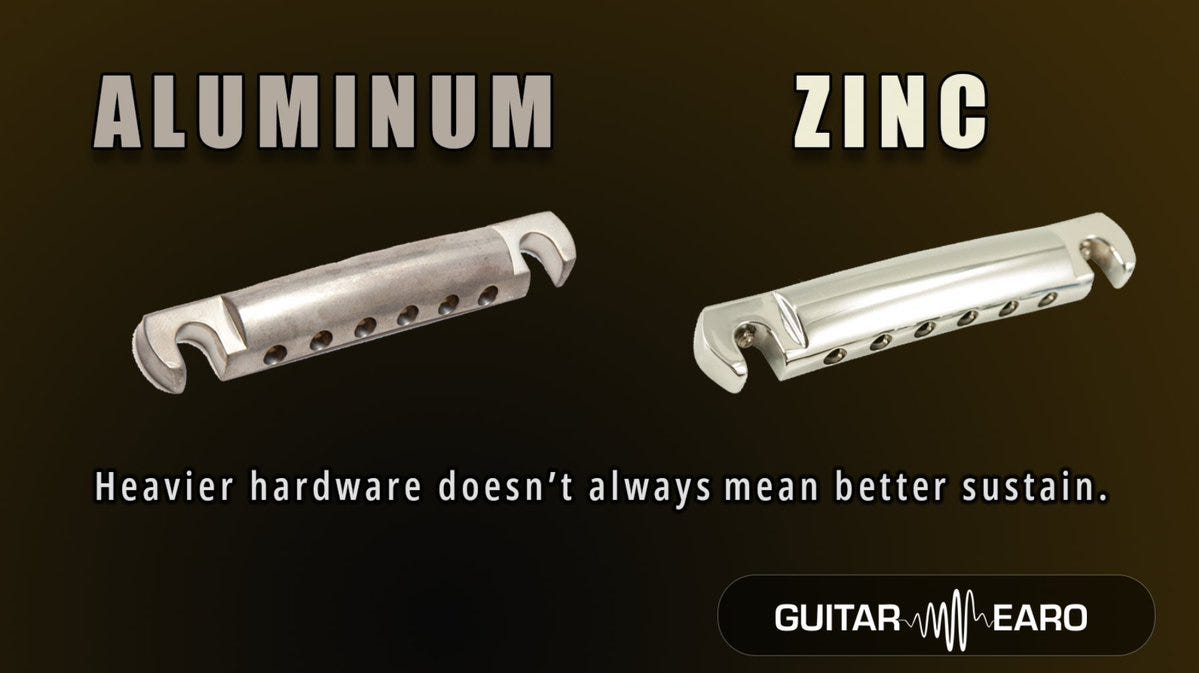The Forgotten Ingredient in ’50s Tone
In the 1950s, Gibson’s stop tailpiece, that unassuming bar anchoring your strings to the body, was made of lightweight aluminum.
It weighed about one ounce (30 grams).
That’s lighter than a Snickers bar.
These early tailpieces are now holy relics in vintage guitar lore, and for good reason. They’re resonant. Notes leap off the string with this dry, woody immediacy that makes the whole guitar feel acoustically alive.
But in the late ’60s, when Gibson came under Norlin ownership, cost-cutting crept in.
Aluminum was out.
Zinc alloy (aka “pot metal”) was in.
It was easier to cast, more durable, and roughly twice the weight.
Gibson never claimed it was an upgrade.
It was just… convenient.
And yet, that quiet metallurgical substitution permanently altered the sonic DNA of every Les Paul that followed.
Weight, Mass, and the Myth of Sustain
Here’s where things get deliciously nerdy.
Conventional wisdom says: heavier equals more <a href="do-heavier-guitars-actually-sustain">sustain</a>.
Reality says: not quite.
The heavier zinc tailpiece tends to emphasize the low mids: a fatter, thicker tone, but often with a slight loss of upper harmonic bloom.
The lightweight aluminum tailpiece, by contrast, gives you a quicker attack, more clarity, and that elusive “air” vintage fans describe as open or breathing tone.
It’s not snake oil. It’s physics.
When you pluck a string, some of that vibration transfers into the hardware.
Heavier metals store more of that energy internally; lighter, stiffer ones pass it back faster.
Result:
Aluminum feels snappy, articulate, and vintage.
Zinc feels dense, slower, and modern.
As one luthier put it:
“The aluminum tailpiece weighs one-quarter of zinc and produces a much different sound: woodier, more airy, richer mids, more upper harmonics.”
And that, right there, is why Gibson’s Historic Reissue line proudly specifies “lightweight aluminum stopbar.”
It’s not nostalgia.
It’s a spec born of measurable acoustic behavior.
The Physics Under the Hood
This is where the geeks among us (welcome, friends) start breaking out calculators.
Vibrational coupling between string → <a href="hardtail-vs-tremolo-does-the-bridge">bridge</a> → tailpiece → body is a complex impedance network.
Mass, rigidity, and damping coefficients determine what frequencies get absorbed, reflected, or <a href="do-heavier-guitars-actually-sustain">sustain</a>ed.
A few key truths:
More mass ≠ more <a href="do-heavier-guitars-actually-sustain">sustain</a>. It’s about how the mass interacts.
Zinc has higher internal damping: it eats treble energy.
Aluminum transmits faster: it lets the wood “speak.”
Brass falls in the middle: warm, harmonically rich.
Steel leans bright and aggressive.
This is measurable. You can literally see it in FFT plots.
The “airy sparkle” of aluminum shows up as slightly stronger high-frequency amplitude above 4 kHz, with faster decay time constants in the low end.
We’re talking subtle (maybe 1–2 dB differences) but on a resonant system like a Les Paul, those subtleties stack.
The Great Aluminum Revival
By the 1990s, as the vintage reissue boom hit full throttle, people started noticing: why do ’50s Les Pauls just sound… different?
Cue the hardware rabbit hole.
Swapping a zinc tailpiece for a lightweight aluminum one became the cheapest “vintage mod” you could do, and the results spoke for themselves.
Suddenly, Norlin-era Les Pauls with $60 aftermarket tailpieces were waking up.
Add locking studs to increase body coupling, and you’re flirting with late-’50s tonal response, without touching the <a href="high-vs-low-the-eternal-pickup-output">pickups</a>.
Of course, nuance matters.
If your guitar is already on the bright side, a heavier zinc piece might actually help “thicken” the tone.
The art lies in balancing the system. Hardware mass vs. wood response vs. pickup voicing.
Beyond the Tailpiece: The Material Rabbit Hole
Once you start listening, you realize: the metal in your hardware shapes your tone almost as much as your pickups.
Gibson’s ’50s Tune-o-matic saddles were brass. Result: warm, chimey, harmonically rich.
In later years: zinc alloy. Result: duller, smoother, less overtone content.
And Telecaster fans? They’ve been arguing about this since Eisenhower was president.
Brass saddles (early ’50s): rounded highs, sweeter mids.
Steel saddles (mid-’50s onward): brighter attack, sharper twang.
The existence of boutique makers like Callaham and Glendale, dedicated to reproducing exact metallurgical compositions from the 1950s, tells you how deep this goes.
For the uninitiated, it seems obsessive.
For tone geeks, it’s the final 5%.
And that 5% is the whole point.
The Periodic Table of Tone
If we had to boil decades of experimentation down to a single chart:
Every material is a tone filter.
Every hardware swap is a subtle EQ curve in physical form.
It’s one of the rare areas in guitar design where metallurgy and musicology overlap perfectly: a kind of accidental physics experiment conducted by generations of players.
Closing Thoughts
The lesson is simple but profound:
Tone is cumulative.
It’s not one magical component.
It’s thousands of tiny interactions between wood, metal, and string tension.
The aluminum vs. zinc debate isn’t about “better” or “worse.”
It’s about how mass, stiffness, and coupling shift the way a guitar breathes.
A tailpiece isn’t just a piece of hardware: it’s a mechanical EQ.
And once you start hearing it, there’s no going back.
Postscript for the Experimenters
If you’re the kind of person who enjoys analyzing pickup inductance, plotting Bode curves, or arguing about dielectric constants in tone caps: you owe it to yourself to A/B an aluminum tailpiece and a zinc one.
Same strings, same setup, same amp.
Record the dry signal and look at the spectrogram.
You’ll see it.
You’ll hear it.
And then you’ll probably spend the rest of your weekend ordering more tailpieces.
Welcome to the rabbit hole.
Learn the Tone.
Save the Sound.




